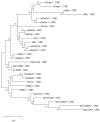Vector and Host C-Type Lectin Receptor (CLR)-Fc Fusion Proteins as a Cross-Species Comparative Approach to Screen for CLR-Rift Valley Fever Virus Interactions
- PMID: 35328665
- PMCID: PMC8954825
- DOI: 10.3390/ijms23063243
Vector and Host C-Type Lectin Receptor (CLR)-Fc Fusion Proteins as a Cross-Species Comparative Approach to Screen for CLR-Rift Valley Fever Virus Interactions
Abstract
Rift Valley fever virus (RVFV) is a mosquito-borne bunyavirus endemic to Africa and the Arabian Peninsula, which causes diseases in humans and livestock. C-type lectin receptors (CLRs) represent a superfamily of pattern recognition receptors that were reported to interact with diverse viruses and contribute to antiviral immune responses but may also act as attachment factors or entry receptors in diverse species. Human DC-SIGN and L-SIGN are known to interact with RVFV and to facilitate viral host cell entry, but the roles of further host and vector CLRs are still unknown. In this study, we present a CLR-Fc fusion protein library to screen RVFV-CLR interaction in a cross-species approach and identified novel murine, ovine, and Aedes aegypti RVFV candidate receptors. Furthermore, cross-species CLR binding studies enabled observations of the differences and similarities in binding preferences of RVFV between mammalian CLR homologues, as well as more distant vector/host CLRs.
Keywords: Aedes aegypti; C-type lectin domain-containing proteins; C-type lectin receptors; Rift Valley fever virus; fusion proteins.
Conflict of interest statement
The authors declare no conflict of interest.
Figures





References
-
- Kuhn J.H., Adkins S., Alioto D., Alkhovsky S.V., Amarasinghe G.K., Anthony S.J., Avšič-Županc T., Ayllón M.A., Bahl J., Balkema-Buschmann A., et al. 2020 taxonomic update for phylum Negarnaviricota (Riboviria: Orthornavirae), including the large orders Bunyavirales and Mononegavirales. Arch. Virol. 2020;165:3023–3072. doi: 10.1007/s00705-020-04731-2. - DOI - PMC - PubMed
MeSH terms
Substances
Grants and funding
LinkOut - more resources
Full Text Sources

